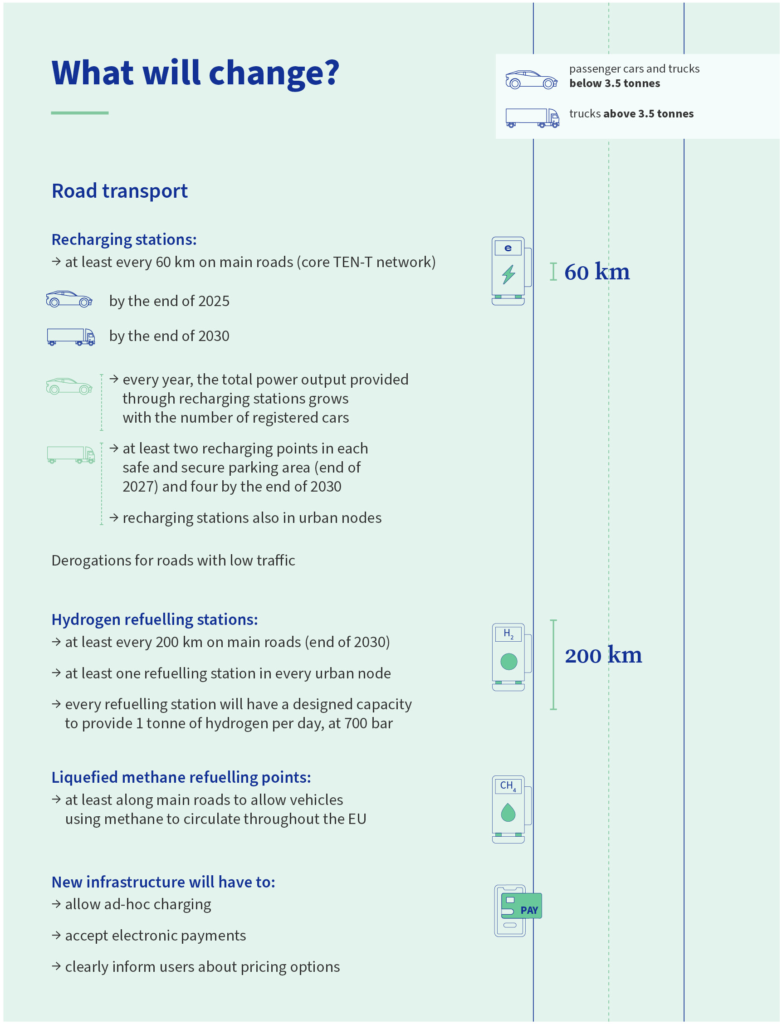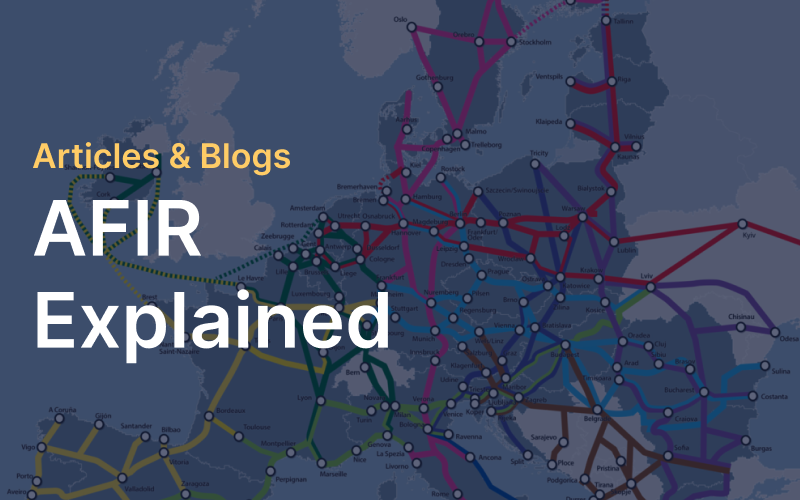1. AFIR: an overview
The Alternative Fuels Infrastructure Regulation is landmark legislation aimed at facilitating the transition to electric vehicles (EVs). It sets binding targets for EU member states to establish charging and refuelling stations along the Trans-European Transport Network (TEN-T), ensuring sufficient infrastructure to meet the projected energy demands of various vehicle types by 2030.

2. Key provisions of AFIR
2.1 Charging infrastructure requirements for passenger cars and vans
AFIR mandates that each EU member state ensures the availability of fast-charging stations for passenger cars and vans every 60 km along the TEN-T core network by 2025 and the comprehensive network by 2030. These charging stations must provide a minimum power output that increases over time to accommodate the growing number of EVs.2.2 Charging infrastructure for heavy-duty vehicles
AFIR also requires the installation of high-power charging hubs for HDVs every 60 km along the TEN-T core network and every 100 km along the TEN-T comprehensive network by 2030. These hubs are designed to support the unique charging needs of electric trucks and buses, which require higher power outputs and faster charging times.2.3 Hydrogen refuelling stations
In addition to electric charging infrastructure, AFIR requires the deployment of hydrogen refuelling stations. Each member state must ensure that hydrogen refuelling stations are available every 200 km along the TEN-T core network by 2030, catering to the anticipated hydrogen-powered vehicle fleet, including both passenger vehicles and HDVs.2.4 Urban and secure parking areas
AFIR addresses the need for charging infrastructure in urban nodes and secure parking areas. Major cities across the EU must install a certain number of charging stations for both passenger vehicles and HDVs. Additionally, designated safe and secure truck parking areas along the TEN-T roads must be equipped with charging stations.
3. Meeting the demand: projected energy needs and infrastructure sufficiency
3.1 Estimating charging energy demand
To estimate the energy demand, AFIR considers the sales targets set by the CO2 standards for different vehicle types. For instance, the European Commission’s proposed 45% CO2 reduction target for HDVs by 2030 implies a public energy demand of approximately 8.13 TWh. Conversely, a more ambitious 65% reduction target would increase the energy demand to around 14.25 TWh. Similarly, the growing fleet of electric passenger cars and vans will also contribute significantly to the overall energy demand.3.2 Infrastructure deployment plans
AFIR’s infrastructure targets, combined with additional national deployment plans, particularly from leading countries like Germany, are expected to provide a robust charging network. By 2030, the annual charging energy available for all vehicle types is projected to be 13.79 TWh, assuming a conservative utilisation rate of high-power chargers.3.3 Hydrogen infrastructure sufficiency
For hydrogen-powered vehicles, the projected demand is around 344,000 tonnes of hydrogen annually by 2030. AFIR’s mandates will cover approximately 98% of this demand, ensuring nearly complete sufficiency in hydrogen refuelling infrastructure.4. Beyond AFIR: national and private initiatives
Several EU member states, including Germany, the Netherlands, and Austria, have announced plans to exceed AFIR’s requirements. Germany, for instance, aims to deploy an additional 1,830 MW of charging power, contributing to a total installed power of over 10,370 MW across Europe by 2030. Moreover, private Charge Point Operators (CPOs) are poised to play a significant role in expanding the charging infrastructure, with plans to install thousands of chargers for both passenger vehicles and HDVs in the coming years.5. Addressing stakeholder concerns and recommendations
5.1 Overcoming infrastructure utilisation challenges
One of the primary concerns raised by stakeholders, such as vehicle manufacturers, is the potential underutilisation of the charging infrastructure. According to the European Automobile Manufacturers’ Association (ACEA), the proposed infrastructure could lead to low utilisation rates, undermining the business viability of CPOs. Therefore, a balanced approach that aligns infrastructure deployment with actual demand is crucial.5.2 Enhancing CO2 reduction targets
Given the projected sufficiency of the charging infrastructure, there is a strong case for increasing the CO2 reduction targets for all vehicle types. A higher target, such as the proposed 65% reduction by 2030 for HDVs and more ambitious targets for passenger vehicles, would ensure optimal utilisation of the infrastructure, providing a solid business case for CPOs and accelerating the transition to electric vehicles.5.3 Policy recommendations
To ensure the successful implementation of AFIR, the following policy recommendations are crucial:- Align CO2 reduction targets with infrastructure capacity: Increase the 2030 CO2 reduction targets for all vehicle types to match the projected charging infrastructure capacity.
- Periodic review and adjustment: Conduct regular reviews of AFIR targets and adjust them based on actual deployment and utilisation data to ensure optimal infrastructure usage.
- Support private investment: Provide incentives and support for private CPOs to invest in charging infrastructure, ensuring a competitive and sustainable market.

